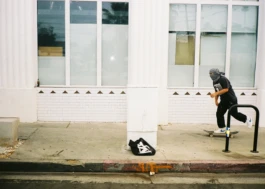
Punk Dreamer
Yudo keeps himself to himself, and I’m not sure what comes first his skating or photography, but he seems pretty talented at both to me. We met in a car park in East LA when the air was thick with smoke. I shot a few portraits of him without any film in my camera, which I guess is why I’m not a photographer. Luckily I don’t think he noticed. Anyway, we spoke about some of his early work photographing his friends and how maybe the future is all about creative micro-communities outside of the major cities.
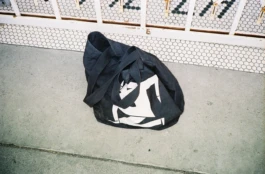
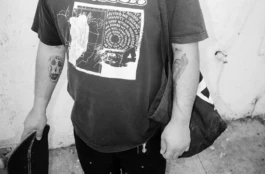
What’s your family heritage? Where did you grow up? And what was the scene like then?
My father is Japanese and my mother is European. I grew up with my mother and sister. I was born in Los Angeles and moved to Carnation, Washington before I was one. We then moved to a suburb of Seattle called Redmond. Redmond was a pretty typical American suburb, an absolute mess and an overall hideous town with a clear divide between the lower middle class and wealthy. While living here I did find skateboarding, which for sure saved me and gave me a family of friends – many much older than myself – who supported me. Eventually my mom moved to Capitol Hill in Seattle, which at the time was a beautiful place for my teenage mind to dive into. The scene on Capitol Hill then was such a blend of culture. My neighborhood was primarily immigrant families – it was one of the more inexpensive neighborhoods in Seattle. It was also the center for the LGBTQ and art communities. So you had a blend of drug dealers, drag queens, skaters, artists, etc., all hanging out together. It was really an amazing place to spend the second half of my teens and beginning of being an “adult”. With all these cultures clashing rarely was there any violence or anything to worry about, everyone was very inviting and kind. Now it seems to have been overrun by tech people. I recently went back to the street I lived on, essentially every house had been torn down and replaced.
“You had a blend of drug dealers, drag queens, skaters, artists etc. all hanging out together.”
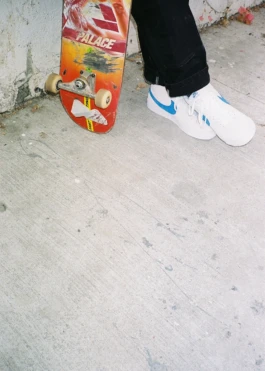
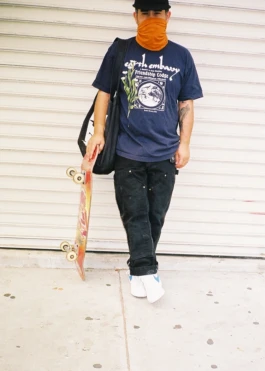
When did you first get into skating and what was the music / fashion vibe at the time?
I found skating at around 12 and initially I was obsessed with Andrew Reynolds, so of course I was drawn to Baker. Tight jeans, leather jackets, Emerica shoes and jumping off big stuff. At the time I was at the end of my first wave of obsession with punk, so it was fitting.
I remember a couple years later one of the skaters I looked up to literally forced headphones on me and made me listen to Hieroglyphics. My mind was blown. It only took a couple weeks for me to transition into wearing Alphanumeric and Shell Toes and trying to learn everything, while looking up to Karl Watson and what was happening to The Bay at that time. The next phase was when I saw Photosynthesis by Alien Workshop, specifically Jason Dill’s part. That video changed everything for me. It essentially made me realize that the coolest thing I could do was be myself. That you did not need to hold to stereotypes or listen to one type of music and dress a certain way or anything like that. It really opened my mind to explore the thing I genuinely cared about.
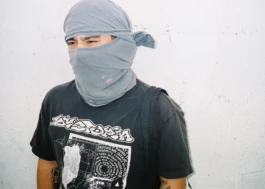
Who inspired you to become a photographer?
When I was about 18 I was snowboarding a lot. I was riding for Salmon Snowboards competing and filming each season. Around 20 I was becoming really disenchanted with the snowboard world. I loved my friends and the act of snowboarding, but the culture was extremely isolated and closed-minded. I had picked up disposable cameras and was just shooting my friends and people in the street. Around the same time my friend Robert LeBlanc ran a gallery in Seattle and we did a group show. That really made me feel like I could do it as a career, which I was extremely naive about. But slowly I got more and more into it.
Viviane Sassen was the first photographer that I got really obsessed with and remains my biggest influence as far as photographers go.
The first time I moved to Los Angeles I lived with my friend Ian Morrison, who was already a working photographer he really taught me how to deal with it as a job and was a big inspiration to pursue it.
I then moved back to Seattle and worked in-house for Nin Troung and Christa Thomas at their studio WKND. They taught me a lot about how to shape things for a brand. I got to do everything from helping produce physical product, to running online sales, to shooting, to art direction etc. They were so patient with me and taught me so much. I already looked up to them for the brands they had done and continue to do. So that was a big inspiration to keep going and push it further.
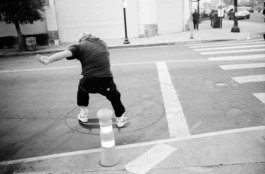
“Maybe I’m just getting old, but I think the idea of creating micro communities of artists and forward-thinking people outside of cities is the future. But maybe this pandemic will drive costs down again, fuck knows.”
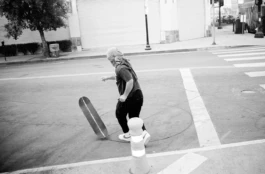
I was looking back over some of your old portraits on Tumblr and seems you were drawn to the young rebels of the world?
Well, those were just my friends. I loved shooting them because I know and respect them so deeply. Eventually I branched out, but for a long time I basically just wanted to shoot my friends.
Any personal photography projects you’re working on right now?
I’ve been working on a large book of photographs, collages, and paintings. It was meant to come out early this year, but there were issues with publishing and then pushed again with Covid. But it should be coming out at some point in the near future.
Do you see a connection between your personal style, skating and photography work?
I think the thing is, growing up as a skateboarder, it really sinks into every aspect of your being, so yes I would say they are all connected.
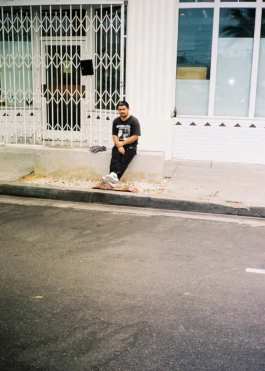
Can you tell me about your work for “Into The Cold”? Seems like an interesting brand with unique sustainability angle.
“Into The Cold” was an intense, beautiful project lead by my good friend Andrew Steiger. Essentially, it was a magazine for a sustainable apparel company. But he pushed it so hard to be more than that, we got to photograph glaciers in Alaska, make wetland installations in warehouses in Los Angeles, and show video pieces at MOCA Salt Lake City – it was amazing. As of now the magazine is done as Andrew is no longer working for the brand, but I would assume he will be coming out with something of his own quite soon.
You also did a Greenpeace project, correct?
Yes, this was also with Andrew. He was working for them and we got to do some projects. Again an amazing experience. Kayaks blockading oil rigs in the Puget Sound (which actually worked and Shell agreed to stop fracking in Alaska), making pieces for Art Basel, and shooting garbage dumps. Andrew is one of my dearest friends and a complete psychopath.
Tell me about the five images you’ve chosen for this story?
I look at photography as a way for me to sort out how I view the world. So it is a never-ending project and a never-ending series in my head. These are random images from the past couple years that I think is a basis for how I view the world to some extent.

Do you see yourself staying in LA? It seems there’s a mass exodus happening in the major US cities right now. What’s your take on that?
Not really, not forever. I would like to get out of America honestly. I have hope for this place because of the people here, but I am pretty over the Stockholm Syndrome of being an American. This place is a fucking mess. Our current path seems to be focused on the terrible things about this country, rather than learning from its mistakes and growing from them. I understand that in a way that is coming from a place of privilege being an American, there are so many people fighting to get here. But I do think America is marketing machine the idea of the dream is sold to everyone but only attainable to very few.
I do also think that we are slowly seeing cities lose their dreaminess and core function. It’s too expensive for young people to really live in them and have space to grow and push their ideas. Maybe I’m just getting older, but I think the idea of creating micro communities of artists and forward-thinking people outside of cities is the future. But maybe this pandemic will drive costs down again, fuck knows.
Best and worst of LA?
YK The best: I live in a house where I am surrounded by trees, but live in a “city”, my friends are amazing, I can skate and ride my bike every day, the people who do do good stuff here do incredible things, it stays being surreal even when you’re sober. The worst: Driving, simulation weather, and that it isn’t a city, but it is a city, but at the same time it’s not really a city at all.
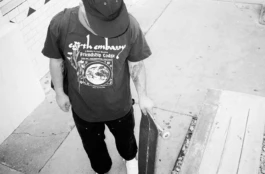
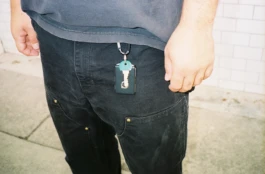

Punk Dreamer
Yudo keeps himself to himself, and I’m not sure what comes first his skating or photography, but he seems pretty talented at both to me. We met in a car park in East LA when the air was thick with smoke. I shot a few portraits of him without any film in my camera, which I guess is why I’m not a photographer. Luckily I don’t think he noticed. Anyway, we spoke about some of his early work photographing his friends and how maybe the future is all about creative micro-communities outside of the major cities.


What’s your family heritage? Where did you grow up? And what was the scene like then?
My father is Japanese and my mother is European. I grew up with my mother and sister. I was born in Los Angeles and moved to Carnation, Washington before I was one. We then moved to a suburb of Seattle called Redmond. Redmond was a pretty typical American suburb, an absolute mess and an overall hideous town with a clear divide between the lower middle class and wealthy. While living here I did find skateboarding, which for sure saved me and gave me a family of friends – many much older than myself – who supported me. Eventually my mom moved to Capitol Hill in Seattle, which at the time was a beautiful place for my teenage mind to dive into. The scene on Capitol Hill then was such a blend of culture. My neighborhood was primarily immigrant families – it was one of the more inexpensive neighborhoods in Seattle. It was also the center for the LGBTQ and art communities. So you had a blend of drug dealers, drag queens, skaters, artists, etc., all hanging out together. It was really an amazing place to spend the second half of my teens and beginning of being an “adult”. With all these cultures clashing rarely was there any violence or anything to worry about, everyone was very inviting and kind. Now it seems to have been overrun by tech people. I recently went back to the street I lived on, essentially every house had been torn down and replaced.
“You had a blend of drug dealers, drag queens, skaters, artists etc. all hanging out together.”


When did you first get into skating and what was the music / fashion vibe at the time?
I found skating at around 12 and initially I was obsessed with Andrew Reynolds, so of course I was drawn to Baker. Tight jeans, leather jackets, Emerica shoes and jumping off big stuff. At the time I was at the end of my first wave of obsession with punk, so it was fitting.
I remember a couple years later one of the skaters I looked up to literally forced headphones on me and made me listen to Hieroglyphics. My mind was blown. It only took a couple weeks for me to transition into wearing Alphanumeric and Shell Toes and trying to learn everything, while looking up to Karl Watson and what was happening to The Bay at that time. The next phase was when I saw Photosynthesis by Alien Workshop, specifically Jason Dill’s part. That video changed everything for me. It essentially made me realize that the coolest thing I could do was be myself. That you did not need to hold to stereotypes or listen to one type of music and dress a certain way or anything like that. It really opened my mind to explore the thing I genuinely cared about.

Who inspired you to become a photographer?
When I was about 18 I was snowboarding a lot. I was riding for Salmon Snowboards competing and filming each season. Around 20 I was becoming really disenchanted with the snowboard world. I loved my friends and the act of snowboarding, but the culture was extremely isolated and closed-minded. I had picked up disposable cameras and was just shooting my friends and people in the street. Around the same time my friend Robert LeBlanc ran a gallery in Seattle and we did a group show. That really made me feel like I could do it as a career, which I was extremely naive about. But slowly I got more and more into it.
Viviane Sassen was the first photographer that I got really obsessed with and remains my biggest influence as far as photographers go.
The first time I moved to Los Angeles I lived with my friend Ian Morrison, who was already a working photographer he really taught me how to deal with it as a job and was a big inspiration to pursue it.
I then moved back to Seattle and worked in-house for Nin Troung and Christa Thomas at their studio WKND. They taught me a lot about how to shape things for a brand. I got to do everything from helping produce physical product, to running online sales, to shooting, to art direction etc. They were so patient with me and taught me so much. I already looked up to them for the brands they had done and continue to do. So that was a big inspiration to keep going and push it further.

“Maybe I’m just getting old, but I think the idea of creating micro communities of artists and forward-thinking people outside of cities is the future. But maybe this pandemic will drive costs down again, fuck knows.”

I was looking back over some of your old portraits on Tumblr and seems you were drawn to the young rebels of the world?
Well, those were just my friends. I loved shooting them because I know and respect them so deeply. Eventually I branched out, but for a long time I basically just wanted to shoot my friends.
Any personal photography projects you’re working on right now?
I’ve been working on a large book of photographs, collages, and paintings. It was meant to come out early this year, but there were issues with publishing and then pushed again with Covid. But it should be coming out at some point in the near future.
Do you see a connection between your personal style, skating and photography work?
I think the thing is, growing up as a skateboarder, it really sinks into every aspect of your being, so yes I would say they are all connected.

Can you tell me about your work for “Into The Cold”? Seems like an interesting brand with unique sustainability angle.
“Into The Cold” was an intense, beautiful project lead by my good friend Andrew Steiger. Essentially, it was a magazine for a sustainable apparel company. But he pushed it so hard to be more than that, we got to photograph glaciers in Alaska, make wetland installations in warehouses in Los Angeles, and show video pieces at MOCA Salt Lake City – it was amazing. As of now the magazine is done as Andrew is no longer working for the brand, but I would assume he will be coming out with something of his own quite soon.
You also did a Greenpeace project, correct?
Yes, this was also with Andrew. He was working for them and we got to do some projects. Again an amazing experience. Kayaks blockading oil rigs in the Puget Sound (which actually worked and Shell agreed to stop fracking in Alaska), making pieces for Art Basel, and shooting garbage dumps. Andrew is one of my dearest friends and a complete psychopath.
Tell me about the five images you’ve chosen for this story?
I look at photography as a way for me to sort out how I view the world. So it is a never-ending project and a never-ending series in my head. These are random images from the past couple years that I think is a basis for how I view the world to some extent.

Do you see yourself staying in LA? It seems there’s a mass exodus happening in the major US cities right now. What’s your take on that?
Not really, not forever. I would like to get out of America honestly. I have hope for this place because of the people here, but I am pretty over the Stockholm Syndrome of being an American. This place is a fucking mess. Our current path seems to be focused on the terrible things about this country, rather than learning from its mistakes and growing from them. I understand that in a way that is coming from a place of privilege being an American, there are so many people fighting to get here. But I do think America is marketing machine the idea of the dream is sold to everyone but only attainable to very few.
I do also think that we are slowly seeing cities lose their dreaminess and core function. It’s too expensive for young people to really live in them and have space to grow and push their ideas. Maybe I’m just getting older, but I think the idea of creating micro communities of artists and forward-thinking people outside of cities is the future. But maybe this pandemic will drive costs down again, fuck knows.
Best and worst of LA?
YK The best: I live in a house where I am surrounded by trees, but live in a “city”, my friends are amazing, I can skate and ride my bike every day, the people who do do good stuff here do incredible things, it stays being surreal even when you’re sober. The worst: Driving, simulation weather, and that it isn’t a city, but it is a city, but at the same time it’s not really a city at all.

